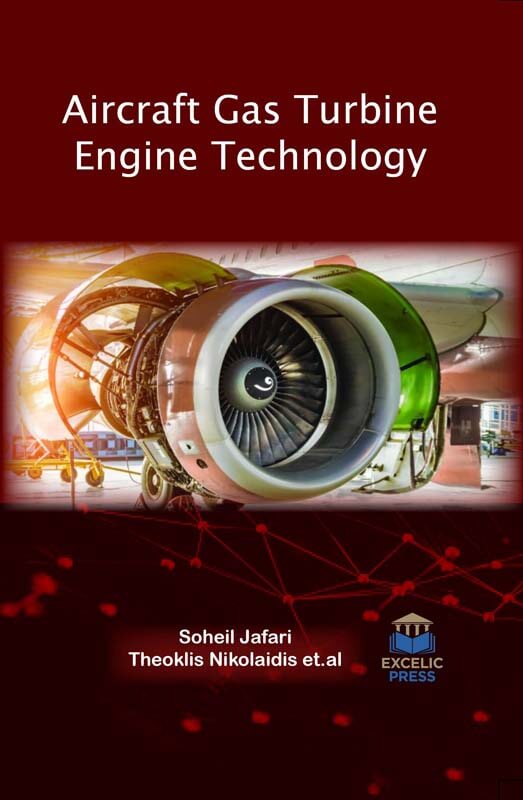Future gas turbine aero engines will be more efficient, compact and will have more electric parts. Today’s aircraft engines are made safer by increasing the number of control parameters and sensors. Gas turbine engines are constituted of a complex system. Their desired performance can guarantee aircraft flight safety. Because aircraft engines operate at high temperatures, high pressures, and high speeds, there are lots of possibilities of various faults in the aircraft. Gas turbine engines show the effects of wear and tear over time. This performance is impressed by some engine input controlling functions which are changing with the development of engines. Finding these functions can be a great success in the jet engine control issue.
Aircraft Gas Turbine Engine Technology examines the current state-of-the-art technology and materials applied in aircraft gas turbine engines and portrays the trends in future materials. The authors are leading experts in their fields. The book starts with a chapter that examines and analytically reviews the thermal management systems proposed over the past six decades for gas turbine civil aero engines to establish the evident system shortcomings and to identify the remaining research questions that need to be addressed to enable this important technology to be adopted by next generation of aero engines with complicated designs. Improvements in propulsive efficiency – and hence engine SFC at a given thermal efficiency – can be achieved by designing an engine at a lower specific thrust. The book, therefore, presents a research work focused on identifying several novel engine cycles and technologies. Hypersonic travel in recent decades has been an important area of research interest in the aerospace sector due to its potential in military and civil applications. In particular, hypersonic air-breathing propulsion vehicles can offer a replacement for the conventional subsonic modes of commercial transport with a new class of flight vehicles that can offer time-saving means of transportation for long-range flights.
Further, the book details an optimal method of ramjet exhaust expansion to produce sufficient thrust to propel the vehicle into altitudes and Mach regimes where scramjet operation can be initiated. This aspect includes a Computational Fluid Dynamics (CFD)-based geometric study to determine the optimal configuration to provide the best thrust values. In the following chapters, the book includes an assessment of combustor working environments; developments of gas turbine combustors for air-blown and oxygen-blown IGCC; aircraft flight modeling during the optimization of gas turbine engine working process; a thermodynamic analysis of the pressure gain of continuously rotating detonation combustor for gas turbine; and thermodynamic designing of the small-scale gas turbine engine family with common core.
In addition, the optimization study of the dump diffuser in a gas turbine to reduce pressure loss is portrayed. The book closes with a successful approach in designing a Fuzzy Logic Controller (FLC) for a specific Jet Engine. During the last five decades, most of the control problems have been formulated by the objective knowledge of the given systems. Many of those “model-base” approaches have found their method to observe and provided satisfactory solutions to the spectrum of complicated systems. This book will serve as a valuable guide for engineers and researchers as well as the students will find the material value in their work.














Davidblics –
Kamagra pharmacie en ligne: kamagra en ligne – achat kamagra
BradleyKig –
Achetez vos kamagra medicaments: kamagra 100mg prix – Achetez vos kamagra medicaments
BernardSwefe –
kamagra 100mg prix: acheter kamagra site fiable – kamagra 100mg prix
BradleyKig –
Pharmacie sans ordonnance: pharmacie en ligne sans ordonnance – pharmacie en ligne pas cher pharmafst.com
BradleyKig –
kamagra livraison 24h: Kamagra Commander maintenant – kamagra 100mg prix
BernardSwefe –
Tadalafil 20 mg prix sans ordonnance: cialis prix – Acheter Viagra Cialis sans ordonnance tadalmed.shop
BernardSwefe –
vente de mГ©dicament en ligne: Meilleure pharmacie en ligne – vente de mГ©dicament en ligne pharmafst.com
BernardSwefe –
Kamagra Oral Jelly pas cher: kamagra pas cher – kamagra 100mg prix
BernardSwefe –
Acheter Kamagra site fiable: kamagra pas cher – Kamagra pharmacie en ligne
Stevenhef –
legitimate canadian online pharmacies: Express Rx Canada – the canadian drugstore
Stevenhef –
mexico drug stores pharmacies: RxExpressMexico – buying prescription drugs in mexico
Stevenhef –
Rx Express Mexico: RxExpressMexico – Rx Express Mexico
MichaelNot –
canadian pharmacy antibiotics: Generic drugs from Canada – legal to buy prescription drugs from canada
Stevenhef –
cheapest online pharmacy india: indian pharmacy – indian pharmacy online shopping
Michaelfom –
Medicine From India [url=https://medicinefromindia.com/#]indian pharmacy online[/url] MedicineFromIndia
MichaelNot –
indian pharmacy: Medicine From India – indian pharmacy online
Stevenhef –
Rx Express Mexico: mexico drug stores pharmacies – reputable mexican pharmacies online
Michaelfom –
maple leaf pharmacy in canada [url=https://expressrxcanada.shop/#]ExpressRxCanada[/url] rate canadian pharmacies
Stevenhef –
canada drugs online review: Express Rx Canada – canada pharmacy
MichaelNot –
Rx Express Mexico: mexican online pharmacy – Rx Express Mexico
Stevenhef –
recommended canadian pharmacies: Canadian pharmacy shipping to USA – canadian 24 hour pharmacy
Michaelfom –
mexico pharmacy order online [url=https://rxexpressmexico.com/#]mexico drug stores pharmacies[/url] mexico pharmacies prescription drugs
MichaelNot –
mexican rx online: best online pharmacies in mexico – pharmacies in mexico that ship to usa
Michaelfom –
Rx Express Mexico [url=https://rxexpressmexico.com/#]Rx Express Mexico[/url] RxExpressMexico
Stevenhef –
indian pharmacy online shopping: Medicine From India – Medicine From India
Brianpes –
пин ап казино официальный сайт: пинап казино – пин ап казино
Brianpes –
вавада казино: вавада зеркало – vavada
Brianpes –
vavada casino: вавада – вавада официальный сайт
Brianpes –
pin-up: pin up azerbaycan – pin up azerbaycan
Brianpes –
pin up вход: пин ап вход – пин ап казино официальный сайт
Brianpes –
pin up casino: pin up azerbaycan – pin up az
Brianpes –
pin up azerbaycan: pinup az – pin up
Brianpes –
вавада зеркало: вавада казино – вавада казино
Brianpes –
pin up: pin-up – pin up casino
Brianpes –
пин ап вход: пин ап зеркало – pin up вход
Kennethwhary –
pin up: pinup az – pin up
Kennethwhary –
vavada вход: вавада казино – vavada
Kennethwhary –
pin up вход: пин ап казино официальный сайт – пин ап казино
Kennethwhary –
пин ап зеркало: пинап казино – пинап казино
Kennethwhary –
pin-up: pin up – pinup az
Kennethwhary –
вавада официальный сайт: вавада официальный сайт – вавада официальный сайт
Elmersob –
пин ап вход: пин ап казино официальный сайт – пин ап зеркало
Elmersob –
vavada вход: вавада официальный сайт – вавада зеркало
Elmersob –
вавада зеркало: vavada – вавада казино
Elmersob –
пин ап зеркало: пинап казино – пин ап казино
AlbertoKew –
cheap Viagra online: fast Viagra delivery – secure checkout Viagra
AlbertoKew –
same-day Viagra shipping: same-day Viagra shipping – safe online pharmacy
AlbertoKew –
modafinil pharmacy: modafinil pharmacy – safe modafinil purchase
AlbertoKew –
buy modafinil online: modafinil 2025 – modafinil pharmacy
AlbertoKew –
safe online pharmacy: no doctor visit required – generic sildenafil 100mg
AlbertoKew –
legal Modafinil purchase: doctor-reviewed advice – buy modafinil online
AlbertoKew –
discreet shipping: discreet shipping – no doctor visit required
AlbertoKew –
no doctor visit required: order Viagra discreetly – trusted Viagra suppliers
Ronaldsnick –
https://zipgenericmd.com/# order Cialis online no prescription
AlbertoKew –
generic tadalafil: affordable ED medication – discreet shipping ED pills
Jeremysat –
modafinil 2025: verified Modafinil vendors – legal Modafinil purchase
Ronaldsnick –
http://maxviagramd.com/# fast Viagra delivery
Jeremysat –
buy modafinil online: verified Modafinil vendors – safe modafinil purchase
AlbertoKew –
FDA approved generic Cialis: FDA approved generic Cialis – buy generic Cialis online
Jeremysat –
modafinil legality: verified Modafinil vendors – modafinil legality
Ronaldsnick –
https://maxviagramd.shop/# generic sildenafil 100mg
AlbertoKew –
doctor-reviewed advice: safe modafinil purchase – legal Modafinil purchase
Jeremysat –
online Cialis pharmacy: FDA approved generic Cialis – Cialis without prescription
AlbertoKew –
generic sildenafil 100mg: best price for Viagra – order Viagra discreetly
JudsonDIT –
PredniHealth: can you buy prednisone over the counter in mexico – PredniHealth
JudsonDIT –
average cost of prednisone 20 mg: how to get prednisone without a prescription – PredniHealth
JudsonDIT –
Amo Health Care: Amo Health Care – Amo Health Care
JudsonDIT –
PredniHealth: where can i buy prednisone – prednisone online paypal
ScottTaups –
online cialis australia: Tadal Access – cialis online without pres
ScottTaups –
cialis tablet: TadalAccess – whats cialis
ScottTaups –
cialis pills for sale: cialis purchase – is tadalafil and cialis the same thing?
ScottTaups –
tadalafil with latairis: how long does cialis last in your system – adcirca tadalafil
RodneyMeexy –
Online medication store Australia [url=http://pharmau24.com/#]Buy medicine online Australia[/url] PharmAu24
DavidBet –
https://pharmau24.shop/# PharmAu24
Josephlelry –
Ero Pharm Fast: boner pills online – Ero Pharm Fast
CurtisFaill –
erectile dysfunction medications online: Ero Pharm Fast – best online ed meds
RodneyMeexy –
Pharm Au 24 [url=https://pharmau24.com/#]Pharm Au24[/url] online pharmacy australia
Josephlelry –
erectile dysfunction online: cheap ed drugs – ed medicines
DavidBet –
http://eropharmfast.com/# Ero Pharm Fast
Josephlelry –
best online doctor for antibiotics: buy antibiotics from canada – buy antibiotics
CurtisFaill –
buy antibiotics from india: BiotPharm – buy antibiotics
RodneyMeexy –
Ero Pharm Fast [url=https://eropharmfast.shop/#]Ero Pharm Fast[/url] Ero Pharm Fast
CurtisFaill –
low cost ed pills: top rated ed pills – online erectile dysfunction pills
Josephlelry –
Online medication store Australia: pharmacy online australia – online pharmacy australia
CurtisFaill –
Ero Pharm Fast: buy erectile dysfunction pills online – low cost ed meds
RodneyMeexy –
Ero Pharm Fast [url=https://eropharmfast.shop/#]ed meds on line[/url] п»їed pills online
CurtisFaill –
Ero Pharm Fast: erectile dysfunction medication online – where to get ed pills
DavidBet –
https://biotpharm.com/# best online doctor for antibiotics
CurtisFaill –
best online doctor for antibiotics: Biot Pharm – best online doctor for antibiotics
RodneyMeexy –
pharmacy online australia [url=https://pharmau24.shop/#]Discount pharmacy Australia[/url] Pharm Au24
CurtisFaill –
Buy medicine online Australia: Buy medicine online Australia – Pharm Au 24
RodneyMeexy –
Discount pharmacy Australia [url=https://pharmau24.shop/#]Discount pharmacy Australia[/url] PharmAu24
DavidBet –
https://eropharmfast.shop/# Ero Pharm Fast